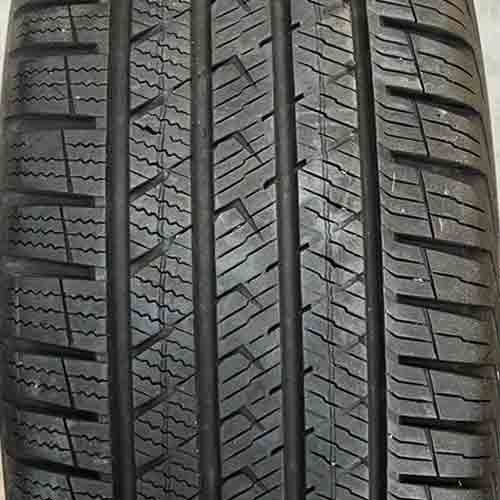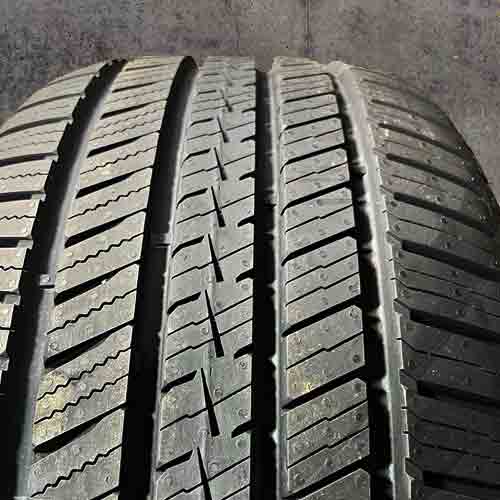Out of both these boys, the Vredestein Hypertrac AS is an ultra-high performance all-season tire, while the Quatrac Pro comes from grand touring all-season category. Let’s find a better fit for you here.

Main Highlights
So overall, the Vredestein Hypertrac is better at:
- Steering Responsiveness: Exhibiting superior side-to-side traction and a more direct steering feedback, particularly in dry conditions.
- Noise Reduction: Utilizing a better pitch sequencing technology to effectively minimize road noise.
- Resistance to Hydroplaning: Featuring well-designed grooves with better interconnected structures.
Whereas the Vredestein Quatrac Pro is better at:
- Dry Braking: Offering shorter stopping distances, particularly when comparing Y speed rated sizes in both tires. (Learn all about speed ratings here).
- Wet Traction: Excelling with its multitude of sipes and flexible rubber composition.
- Winter Performance: Demonstrating better traction, where it leads the most in terms of ice traction, and braking.
Tread Features
First up, the Vredestein Quatrac Pro. This tire showcase an impressive asymmetric tread design.

Now, as you can see (from its tread image), its segmented in to five block columns/ribs, forming 4 circumferential grooves.
The shoulder ribs (on the edges), vary slightly from one another, in terms of siping mostly.
One side has linear sipes, while the other comes with a wave-like pattern.
Though both of them have similar longitudinal voids, acting as biters, and ridges between the lugs.
Moving towards the middle, the central most rib is continuous running, and is equipped with V shaped notches, and linear sipes.
And the adjacent ribs?
Well, these again vary from one, another, where on one side, you see similar siping pattern (as seen on the middle rib), and notches facing outwards.
While the other rib carry wave-like sipes, with proper lateral voids, join the circumferential grooves together.
Moving towards the Vredestein Hypertrac AS, this tire also features an asymmetric tread pattern with five distinctive ribs.

The central rib maintains a continuous design for consistent rubber-to-road contact.
And it’s infused with sharp longitudinal (slanted) notches and lateral siping to improve grip.
Moreover, it also features small laterally arranged notches/biters, facing outwards.
Adjacent (to this middle rib), are block columns that offer varied designs.
One rib here, replicates the siping pattern of the central rib, while the other stands out with its offset edges and wave-like siping, contributing to a different traction profile.
Similarly, the shoulder lugs on each side also vary in terms of sipe design.
Though these shoulder blocks commonly have ridges in between them (on both sides), connecting all lugs together longitudinally. This basically aids the tire’s lateral traction and stability.
Here’s a hint from your tire guru: My main page is the gateway to the best all-season tire choices out there.
Info on Sizes
Vredestein Quatrac Pro comes in 17 to 21 inches, with sizes having following specs.
- Speed ratings: H, V, W and Y.
- Load ratings: SL/XL, (though majority of sizes are XL).
- Weight range: 19 to 37 lbs (heaviest size is 285/40/R22, and the lightest is 205/40/R17).
- Tread depth: 10/32″ on all.
- UTQG: 400 A A.
- Treadwear warranty: 50k miles.
- Also all sizes have rim protectors, and Tri Peak ratings (along with M+S).
- Internally, the tire features a single-ply polyester casing supporting two steel belts, and a single polyamide reinforcement cap ply on top.
Review Quatrac Pro here: https://tiredriver.com/vredestein-quatrac-pro-review/
The Vredestein Hypertrac comes in 16 to 20 inches rims. And these sizes have following specs.
- Speed ratings: W and Y only.
- Load ratings: SL and XL.
- Tread depth: 10.7/32″ on all.
- Weight: 20 to 40 lbs.
- UTQG: 500 AA A.
- Treadwear warranty: 50k miles.
- Internally, the tire offers 2 ply polyester casing with twin steel belts, reinforced by a single ply polyamide layer on very top.
Review Hypertrac tire here: https://tiredriver.com/vredestein-hypertrac-all-season-review/
Dry-Road Performance
A thorough assessment of the tire’s traction and steering response requires a close look at its dry performance.
It’s wise to review traction and steering response as distinct factors, especially when considering how they compare to other tire types, something I discuss in my article on the differences between summer, winter, and all-season tires.
Linear Grip
Directional grip is basically how well a tire sticks to the road when you’re cruising in a straight line.
This kind of grip really leans on the tread’s central part, and you can gauge it by looking at how quickly the tire stops from certain speeds (I checked it out from 60 mph).
Now, out of both tires, the Vredestein Quatrac Pro is taking the lead. It provides better results on tests, stopping almost half a foot shorter on braking tests, on average compared to the HyperTrac.
So why is it better in braking, even though its a grand touring tire?
Well, this enhanced performance is attributed primarily to two factors: the tire’s relatively lighter weight and its efficiently designed central ribs.
The lighter weight reduces the tire’s momentum inertia, making it easier to slow down.
Also, the central rib of the Quatrac Pro is packed with more biting edges, comparatively, where it features V-shaped or arrow-like notches, plus loads more sipes. These bits are awesome for gripping dry roads, even though they’re actually meant for wet ones.
Overall Handling
When you’re looking at dry handling in tires, you’ve got to weigh up both lateral grip and how responsive the steering is.
Starting with lateral grip, it’s all about the tire’s side-to-side stickiness on the road. And here, the tire’s shoulders play a major role.
But why shoulders? Well, because when you turn, the weight on tires, concentrates towards the tread edges.
Now, out of both tires, you get a lot better lateral traction on Vredestein Hypertrac.
It’s got these neat, compact shoulder blocks that are just designed right. They give the tire a bit of an upper hand, where you see a lot better lateral g-force readings, compared to Quatrac Pro.
But why? Well, it boils down to this: the HyperTrac’s shoulders have more rubber hitting the road, and with fewer tread features on them, you get better traction overall.
But the big game-changer is steering responsiveness. This is what really defines a tire’s overall handling.
That’s why with a more direct steering feedback, the HyperTrac All Season consistently clocked more than 2 seconds faster handling lap times on my tests.
This is attributed to the tire’s stiffer rubber composition, and more solid reinforced foundations, and internal construction typical of ultra-high performance tires.
These features keep the lugs from bending. And this is significant because, when lugs bend, they take time to snap back to shape. This delay is the lag between you turning the steering wheel and the wheels responding.
So out of both tires here, the Quatrac Pro lacks in both lateral grip, and steering responsiveness.
For a deeper dive into how this aspect contributes to overall tire performance, take a look at my article discussing the pros and cons of all-season tires.
Wet-Road Performance
The primary concerns in wet conditions are grip and hydroplaning resistance, both achieved through effective water clearing.
I’ve explored this topic further, especially how all-season tires fare in rain, which you can read about here: https://tiredriver.com/are-all-season-tires-good-in-rain/
Wet Traction
Now, grooves (on tread) play a vital role in evacuating most of the water from the road surface, but small residual water droplets can still remain behind, and can come under the tread blocks, leading to slippage.
And that’s where sipes come in, which act as small water reservoirs.
Basically, the moisture coming between the tread and the road, is sucked up by these siping slits, as they flex to create a suction. And as the tire rolls over, those captured water particles are sprayed out.
Now out of both tires, the Vredestein Quatrac Pro not only outperforms HyperTrac, but its actually the best in its grand touring all season category.
This is all because of its multitude of linear and wave-patterned sipes.
Moreover, as the tire features a relatively softer rubber composition, it adds to the effectiveness of the sipes, as with a flexible rubber, these sipes are able to suck up water particles with more ease.
In contrast, while the HyperTrac is capable of efficiently evacuating a large volume of water through its grooves, it does not perform as well in terms of wet traction.
This limitation is primarily due to its lesser number of sipes and their reduced effectiveness, stemming from the tire’s stiffer rubber compound.
For Your Info: Quatrac Pro is ranked in my list of top touring AS tires. See the list here: https://tiredriver.com/best-grand-touring-all-season-tires/
Resistance to Hydroplaning
Hydro, or aquaplaning, happens when water gets trapped between the tread and the road, causing the tires to lose contact and just glide over water.
Now, since most of the water gets out through grooves, its their effectiveness that defines the overall resistance to this hydroplaning.
Now, although both Vredestein boys here offer 4 wide circumferential grooves, you still see a better overall performance on HyperTrac.
This is because the tire offers better inter-connectivity of its longitudinal grooves, and a greater tread depth (on all its sizes). Both of these design elements, aid this tire is expelling greater volume of water, comparatively.
Winter Traction
All-season tires are pretty decent in winter, giving you good control, braking, and acceleration on snow and ice. But let’s face it, grand touring tires usually have the upper hand here, especially when you stack them against high-performance all-season ones.
That’s why among both boys here, the Vredestein HyperTrac showed the most significant shortcomings.
I mean its overall winter performance scores were much lower, comparatively, a conclusion drawn from my series of tests and subjective evaluations.
This under-performance is predominately because of the tire’s relatively stiffer rubber composition, which negatively affects its traction elements (on tread).
I mean, the HyperTrac’s rubber compound does not respond really well to cold temperatures, where its more susceptible to getting more rigid, reducing its grip.
And that figures, since they lacks the 3-peak mountain snowflake (3PMSF) rating, a standard indicating suitability for icy and snowy conditions below 44 °F (7 °C).
On the other hand, the 3PMSF rated Vredestein Quatrac Pro stands out with its relatively more pliant rubber composition, and a greater number of biters, including siping.
These not only provide superior light snow traction, forming optimal snow-to-snow contact, but also on ice, where you need a ton of siping, to provide that micro level bite.
Side Note: If you’re wondering, why snow contact is important, think of it as the snow-ball effective.
Ride Quality
The ability of tires to provide a comfortable ride is linked to how well they can lessen road noise and absorb uneven surfaces.
Let’s analyze each of these elements in detail.
Noise Dampening
Road noise mostly comes from the sound of air hitting the tire tread. This is especially true for the gaps around the tire’s edges, which can get pretty loud.
Here’s how it works: air particles sneak through the grooves on the tire’s shoulder, where they smack into the tread walls. This collision creates noise, which then echoes and contributes to the overall sound level from the tread.
Now, the HyperTrac is pretty good at keeping things quieter. Its rubber composition doesn’t reflect sound waves as much. Plus, it uses this cool thing called pitch sequencing technology. It’s all about varying the angles of the tread blocks to work together in reducing noise. It’s like the different pitches from the blocks try to cancel each other out.
But then there’s the Quatrac Pro. With its winter tire-style siping and loads of biting edges, it tends to be noisier, predominately producing louder growling sounds.
Vibrations Comfort
Ride comfort is largely determined by a tire’s capacity to absorb the shocks from road imperfections, which is influenced by both the rubber’s composition and the tire’s tread design.
Now, here, with a more pliant winter traction focused rubber, the Quatrac Pro nudges out a little bit, giving out slightly better overall comfort scores.
Basically with a more pliant tread, lugs are engineered to flex more. And although it impacts the overall steering responsiveness, it so uses up/converts vibrations’ energy to bend the lugs, technically absorbing them.
This dynamic quality enables the tire to conform to road anomalies, absorbing impacts and contributing to a more comfortable driving experience.
Though don’t get me wrong, the HyperTrac is one of the best tires in its category, when it comes to impact comfort performance.
Verdict
With all the twists and turns in our comparison, let’s steer towards the conclusion.
Now, here the Quatrac Pro leads in dry-road braking, though lacks to its high performing counterpart in terms of steering and handling.
Wet conditions also bring out varying results, where although HyperTrac provides superior hydroplaning resistance, the overall wet traction is better on its counterpart.
On snow though, we have QuaTrac Pro as a clear winner, and yes, the tire also performs better in bumps reduction, and overall in terms of fuel economy and tread life, though lacks to its counterpart, in terms of noise dampening performance.